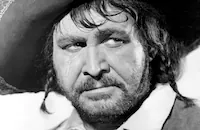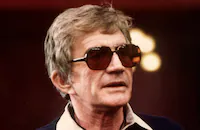Marine Raiders

Brief Synopsis
Cast & Crew
Harold Schuster
Pat O'brien
Ruth Hussey
Robert Ryan
Frank Mchugh
Barton Maclane
Film Details
Technical Specs

Synopsis
In the wake of Japanese attacks on Guadalcanal, Captain Dan Craig of the Paramarines and Major Steve Lockhard of the U.S. Marine Corps report to the island and are ordered to repel the Japanese troops. When Dan discovers the body of one of his men, Lt. Tony Hewitt, sadistically tortured and murdered by the Japanese, he goes berserk and charges into the jungle. After restraining Dan, Steve warns his friend that he must learn to control his impulses. With their mission completed, the troops are relieved and board a ship bound for Australia. In an Australian bar, Dan meets Ellen Foster, a member of the Woman's Airforce Auxiliary. Sensing Dan's restlessness, Ellen is sympathetic to him, and he asks to take a drive in her car. As they drive along the beach, Ellen confides her concerns about her two brothers who are serving in Africa. After dancing away most of the night, the couple walk along the beach and realize that they have fallen in love. When Dan tells Ellen that he is leaving on duty the next morning, she suggests they immediately marry, but Dan demurs, claiming that wartime life is too uncertain to make such a serious commitment. When Ellen protests that, despite the uncertainty, she is still willing to take a chance, Dan reconsiders, and they search out a minister. Before they can reach the minister, however, Dan is wounded in a surprise air attack and hospitalized. After Ellen leaves Dan's bedside to go on duty, Steve visits his friend with orders to return to the U.S. When Dan informs him of his impending marriage, Steve thinks that his friend has succumbed to the charms of a woman while in an emotionally unstable state and arranges for him to be shipped out with the rest of the troops. Upon returning to the hospital, Ellen learns that Dan has gone and watches as his ship disappears into the night. Steve's actions cause Dan to renounce their friendship, and as a result, when the two arrive at the naval base in San Diego, they are barely speaking to each other. When they are both assigned to teach the raw recruits of Camp Elliott the art of modern combat, Dan protests that he would rather go back to the front, but his request is denied. While in town one night, Dan unsuccessfully tries to contact Ellen, and afterward, he overhears Jimmy Fowler and Sally Parker tearfully record their farewells before Jimmy is sent overseas. On the drive back to camp, Jimmy asks Dan's advice about marrying Sally, and Dan asserts that, as participants in the war, women are fully aware of the dangers. At the base, Steve is ordered to lead the troops into action, but a general, sensing Dan's instability, assigns him to a desk job in Washington, D.C. Steve defends Dan's behavior, claiming that he caused his friend's unhappiness by breaking up his romance. The general accepts Steve's explanation, and the two men return to Australia to spearhead the invasion of an enemy island. With less than forty-eight hours before the start of their mission, Dan finds Ellen and they are finally married. The next morning, Ellen introduces herself to Steve as Dan's wife. In the last hours before shipping out, Steve, Dan and Ellen celebrate, and as Steve goes to lead his troops, Ellen offers him her friendship and he comes to accept her as one of his family. Early the next morning, Ellen bids Dan a tearful farewell and he joins his men. As Dan takes to the air with his Paramarines, Steve commands the landing forces at sea. Dan and his men parachute over the island, their mission to block the roads and delay enemy reinforcements so that the Marines can land. When Dan's troops are outflanked by enemy forces, Steve orders them to pull back to the beach, but in a daring maneuver, Dan rallies his men to overtake the enemy machine guns firing from the hills. With the enemy firepower eliminated, the U.S. forces land and secure the beachhead. In Australia, as Ellen listens to a radio broadcast announcing the success of Dan's mission, she steps onto the airstrip and utters words of inspiration to her husband across the sea.

Director
Harold Schuster
Cast

Pat O'brien

Ruth Hussey

Robert Ryan

Frank Mchugh

Barton Maclane

Richard Martin
Edmund Glover

Russell Wade
Robert Andersen

Michael St. Angel

Martha Macvicar
Harry Brown
Sammy Stein
Edward Fielding
William Forrest
Richard Davies
Jimmy Jordan
Chris Drake
Tom Burton
Mike Kilian
Patrick O'moore
Patricia Cameron
Robert Dane
Steve Winston
Herbert Clifton
Audrey Manners
John Rogers
Peter Dane
Cliff Clark
Tony Hughes
Selmar Jackson
Stanley Price

Don Dillaway
Carl Kent

Glenn Vernon

Blake Edwards
James Damore
Melvin Mix
Jimmy Evans
James Hamilton
Jack Reeves
Eddie Lee
James B. Leong
Harold Fong
Albert Law
John Shaw
Harry Clay
Jon Davison
Bert Moorhouse

Eddie Woods
Jack Louque
Gordon Carveth
Steve Barclay
Barry Macollum
Daun Kennedy
Mike Lally
Isabel O'madigan

Eddie Acuff
John Sheehan
Frank Dawson
Fred Sherman
John Elliott
Laurie Sherman
George Ford
Crew
C. Bakaleinikoff
Mel Berns
Captain Clay Boyd U.s.m.c.
Melville Burke
Albert S. D'agostino
Warren Duff
Warren Duff
Robert Fellows
Walter E. Keller
Edward Killy
Philip Martin Jr.
Harley Miller
Nicholas Musuraca
Jerome Odlum
Martin Rackin
Sam Ruman
Darrell Silvera
Edward Stevenson
James G. Stewart
James S. Thomson
Vernon L. Walker
Roy Webb
Robert Wise

Film Details
Technical Specs

Articles
Marine Raiders -
By Frank Miller

Marine Raiders -
Robert Wise (1914-2005)
Born on September 10, 1914 in Winchester, Ind., Wise was a child of the Depression who quit college to earn a living in the movie industry. He began as an assistant cutter at RKO, where he worked his way up to the position of film editor and earned an Oscar® nomination for his bravura work with Orson Welles on Citizen Kane. He also edited The Magnificent Ambersons (1942) for Welles, along with several other RKO films.
Wise became a director by default when RKO and producer Val Lewton assigned him to The Curse of the Cat People (1944) after Gunther von Fritsch failed to meet the film's production schedule. Wise turned the film into a first-rate psychological thriller, and enjoyed equal success with another Lewton horror film, The Body Snatcher (1945).
Critical praise also was showered upon Wise's Born to Kill (1947), a crime melodrama; and Blood on the Moon (1948), an unusual psychological Western starring Robert Mitchum. Even more highly regarded was The Set-Up (1949), a no-punches-pulled boxing drama that won the Critics' Prize at the Cannes Film Festival. Wise moved on from RKO in the early 1950s, directing one of the movies' classic alien invasion films, The Day the Earth Stood Still, for 20th Century Fox.
At MGM he directed Executive Suite (1954), a compelling all-star boardroom drama; Somebody Up There Likes Me, a film bio of boxer Rocky Graziano that established Paul Newman as a major star; and The Haunting (1963), a chilling haunted-hause melodrama. His films for United Artists include Run Silent, Run Deep (1958), a submarine drama with Clark Gable and Burt Lancaster; I Want to Live! (1958), a harrowing account of a convicted murderess on Death Row, with Susan Hayward in her Oscar-winning performance; and the crime caper Odds Against Tomorrow (1959).
Wise served as president of the Academy of Motion Picture Arts and Sciences and the Directors Guild of America. He was awarded the Academy's Irving G. Thalberg Memorial Award in 1966, and the Directors Guild's highest honor, the D.W. Griffith Award, in 1988. He remained active as a director through the 1970s. His final film, Rooftops (1989) was a musical with an urban setting that recalled West Side Story.
The films in TCM's salute to Robert Wise are Citizen Kane (1941), The Magnificent Ambersons (1942), The Curse of the Cat People (1944), The Body Snatcher (1945), Born to Kill (1947), Blood on the Moon (1948), The Set-Up (1949), Executive Suite (1954), Somebody Up There Likes Me (1956), Run Silent, Run Deep (1958), B>West Side Story (1959), Odds Against Tomorrow (1959) and The Haunting (1963).
by Roger Fristoe
Robert Wise (1914-2005)
Quotes
Trivia
Notes
The opening credits include the following acknowledgment: "We gratefully acknowledge the cooperation of the United States Marine Corps, the Navy, the Coast Guard and Army, whose assistance made this picture possible." According to the Variety review, the U.S. government provided the film clips of naval attacks on Guadalcanal and the sequence detailing the training of Marine recruits at Camp Elliott, CA. Although a pre-production news item in Los Angeles Times credits actor Don Barry with the original story, Barry is not credited by any other source, and the extent of his contribution to the released film has not been determined. Pre-production news items in Hollywood Reporter add that Anne Shirley and Tom Bryson were considered for leading roles in the film and Ray Enright was intially slated to direct. Ruth Hussey was finally borrowed from M-G-M to play the female lead. Although a Hollywood Reporter production chart places Barbara Hale, Lawrence Tierney and Joseph Vitale in the cast, they do not appear in the released film. Other items in Hollywood Reporter add that background footage was shot at various Marine training camps around San Diego, CA. A January 20, 1944 Hollywood Reporter news item notes that Robert Wise directed pickup shots and added scenes. According to Hollywood Reporter, the Los Angeles premiere was staged at the Grauman's Chinese Theatre on July 19, 1944 to climax a Marine Day Bond Drive benefiting the Marine Corps League.















